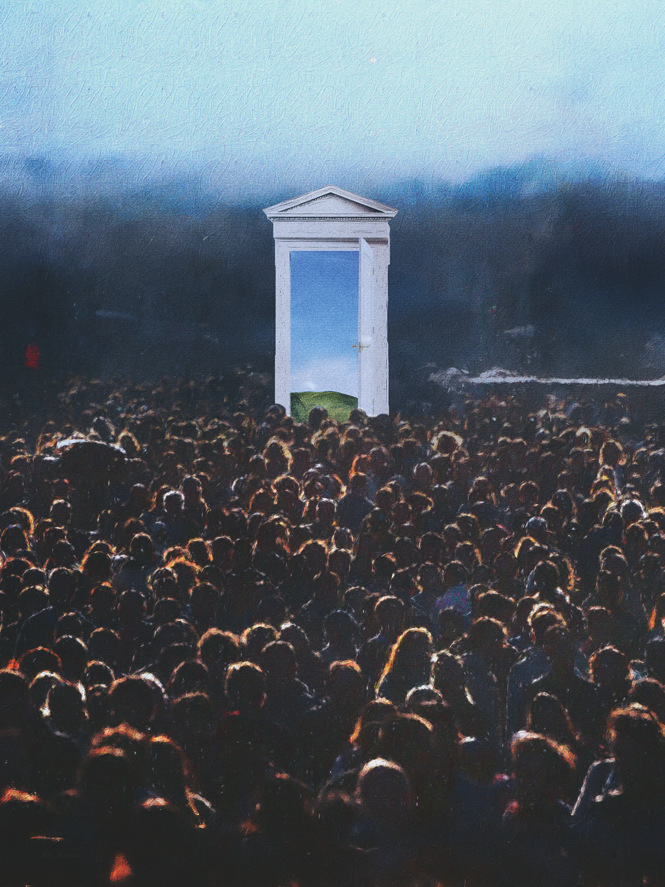ARTICLE AD BOX
Illustrations by Nicolás Ortega
Editor’s Note: This article is part of “The Unfinished Revolution,” a project exploring 250 years of the American experiment.
Other peoples have risen. Other peoples have risen up to defend their rights, their dignity, and their democracies. In the past 50 years, they’ve done it in Poland, South Africa, Lebanon, South Korea, Ukraine, East Timor, Serbia, Madagascar, Nepal, and elsewhere.
In the early 1970s, for instance, the democratically elected leader of the Philippines, Ferdinand Marcos, tried to centralize power in his own hands. Students rose up: A clash between them and police left six protesters dead. Transit workers went on strike, followed by joint student-worker demonstrations. Marcos countered by declaring martial law. Led by Cardinal Jaime Sin, the archbishop of Manila, Catholics arose to resist.
In 1983, Marcos’s key opponent, Benigno Aquino, was assassinated. Marcos banned TV coverage of Aquino’s funeral. But 2 million mourners showed up for what turned into an 11-hour rally against the regime. The middle and professional classes then joined the protesters. The Manila business community held weekly demonstrations. The following year, there was a general workers’ strike. After Marcos stole the next election, members of the armed forces began to mutiny. Millions of ordinary citizens marched to defend them. The Reagan administration threatened to cut off aid to the regime. By early 1986, Marcos and his family had no choice: They fled the country. It had taken more than a decade, but the people had defeated the autocrat.
Such uprisings are not rare. For their 2011 book, Why Civil Resistance Works, the political scientists Erica Chenoweth and Maria Stephan looked at 323 resistance movements from 1900 to 2006, including more than 100 nonviolent resistance campaigns. What Chenoweth and Stephan showed is that citizens are not powerless; they have many ways to defend democracy.
For the United States, the question of the decade is: Why hasn’t a resistance movement materialized here? The second Trump administration has flouted court decisions in a third of all rulings against it, according to The Washington Post. It operates as a national extortion racket, using federal power to control the inner workings of universities, law firms, and corporations. It has thoroughly politicized the Justice Department, launching a series of partisan investigations against its political foes. It has turned ICE into a massive paramilitary organization with apparently unconstrained powers. It has treated the Constitution with disdain, assaulted democratic norms and diminished democratic freedoms, and put military vehicles and soldiers on the streets of the capital. It embraces the optics of fascism, and flaunts its autocratic aspirations.
I am not one of those who believe that Donald Trump has already turned America into a dictatorship. Yet the crossing-over from freedom into authoritarianism may be marked not by a single dramatic event but by the slow corrosion of our ruling institutions—and that corrosion is well under way. For 250 years, the essence of America’s democratic system, drawing on thinkers going back to Cicero and Cato, has been that no one is above the law. Public officials’ first duty is to put the law before the satisfaction of their own selfish impulses. That concept is alien to Trump.
Although Trump’s actions across these various spheres may seem like separate policies, they are part of one project: creating a savage war of all against all and then using the presidency to profit and gain power from it. Trumpism can also be seen as a multipronged effort to amputate the higher elements of the human spirit—learning, compassion, science, the pursuit of justice—and supplant those virtues with greed, retribution, ego, appetite. Trumpism is an attempt to make the world a playground for the rich and ruthless, so it seeks to dissolve the sinews of moral and legal restraint that make civilization decent.
If you think Trumpism will simply end in three years, you are naive. Left unopposed, global populism of the sort Trumpism represents could dominate for a generation. This could be the rest of our lives, and our children’s, too.
So why are we doing so little? Are we just going to stand in passive witness to the degradation of our democracy?
By this past spring, Trump’s actions had become so egregious that I concluded that the time for a mass civic uprising had arrived. On April 17, I published a column in The New York Times arguing that all sectors of America needed to band together to create an interconnected resistance coalition.
That column got an enormous amount of attention and support. For a moment, I thought the mass civic uprising I was hoping for was at hand. So where is it? Yes, there were the (very good) “No Kings” rallies in June. And yes, groups such as Indivisible continue to organize conventional progressives. But for the most part, a miasma of passivity seems to have swept over the anti-Trump ranks. Institution after institution cuts deals with the Trump-administration extortion racket. In private, business leaders will complain about the damage Trump is doing—but in public, they are lying low. University presidents were galvanized by Harvard’s initial decision to stand up for itself, but many other schools (including now possibly Harvard) have agreed to pay what are in effect compulsory bribes to the Trump administration.
We all understand the first reason many people and institutions have remained quiet: intimidation. Leaders say, If I speak out, it will cost my organization millions. Acquiescence to the government begins to seem prudent. So instead of a mass movement, we have separate institutions each drawing up a self-preservation strategy. In the absence of a broad social movement to support and protect them, leaders all face the same collective-action problem: If I stand alone, I’ll be crushed.
The problem with this strategy is that it allows dominance to become a habit. Bullies who go unresisted keep on dominating. Submission becomes a habit too. One way to tell if you’re living in an autocracy is by asking this question: Do people feel free to express their dissent? All around me, I see civic leaders not saying what’s really on their mind. And over time, self-censorship can lead to internal spiritual and moral collapse. When Trump initially defeated the GOP establishment a decade ago, the conquered went along only grudgingly, maintaining their capacity to be privately appalled by him. But over the years, acquiescence appears to have bled inward—and before long, they were conquered on the inside, too. They have become the very people who, not so long ago, they professed to be appalled by.
But a second reason people are quiescent is that they don’t understand the fight we are in. They’re still thinking in conventional political terms. This crisis is not about election cycles. It’s about historical tides. Every so often, a political-cultural-social tide sweeps the world, leaving everything rearranged in its wake. Two hundred and fifty years ago, the democratic tide swept across the West, producing the American and French Revolutions and eventually the democratic revolts of 1848. The totalitarian tide of the early 20th century produced revolutions in Russia, Germany, and China. The 1960s gave us the tide of liberation, which produced the decolonization movements, the civil-rights movement, and the feminist movement. The neoliberal revolution of the 1980s and ’90s produced Ronald Reagan and Margaret Thatcher in the West and Deng Xiaoping and Mikhail Gorbachev in the East. Since 2010 or so, the tide of global populism has risen, a movement that has brought us not just Trump, but Viktor Orbán, Narendra Modi, the revanchist version of Vladimir Putin, Xi Jinping, and Brexit. Drowning in this historic tide, conventional parties and politicians, whose time horizon doesn’t stretch past the next election, are hapless. Conventional politicians don’t have the vision or power to reverse a historical tide. Chuck Schumer is not going to save us.
Trumpism, like populism, is more than a set of policies—it’s a culture. Trump offers people a sense of belonging, an identity, status, self-respect, and a comprehensive political ethic. Populists are not trying to pass this or that law; they are altering the climate of the age. And Democrats think they can fight that by offering some tax credits?
To beat a social movement, you must build a counter social movement. And to do that, you need a different narrative about where we are and where we should be heading, a different set of values dictating what is admirable and what is disgraceful. If we fail to build such a movement, authoritarian strongmen around the globe will dominate indefinitely.
Will enough Americans rise up to reverse the tide of populist authoritarianism? The Filipinos did it under Marcos. One morning the autocrats woke up and were no longer in control; the marchers were. That needs to happen here.
[Adrienne LaFrance: A ticking clock on American freedom]
When we think of social movements, we think of rallies, protests, marches. But those tend to come at the tail end of a social movement. Rallies and marches are pointless if they are not done on behalf of an overarching ideal.
Historical tides shift when there is a shift in values. A group of thinkers conceives a new social vision, and eventually, a social and political movement coalesces around it. John Locke and other Enlightenment thinkers came up with the ideas that made the Declaration of Independence and thus the Revolution possible. In 1848, Karl Marx and Friedrich Engels created the vision for what became the Communist revolutions of the 20th century. Friedrich Hayek, Milton Friedman, and William F. Buckley Jr., among others, created the vision for what became the Reagan Revolution.
What became Trumpian populism drew on older movements—such as the anti-immigrant Know-Nothing party of the 19th century and the isolationist America Firsters of the 20th—and then coalesced over the past eight decades, in the writings of people such as Albert Jay Nock, James Burnham, Sam Francis, Pat Buchanan, and Christopher Lasch. Lasch’s 1995 book, The Revolt of the Elites and the Betrayal of Democracy, is to MAGA what Marx was to Lenin. Almost everything that Trump and J. D. Vance are saying today was said first by Lasch 30 years ago: The establishment betrayed the people and created a culture that makes the working class feel like strangers in their own land.
About a decade ago, I stopped by the desk of a young man named James Hitchcock, who was then my brilliant and generally wonderful editorial assistant at the Times. The Revolt of the Elites was lying on his desk. How odd, I thought, that James would be reading a 20-year-old book of social criticism. I failed to see this for the early warning it was: James is now a speechwriter for Vance. The vice president channels Lasch, and millions of Americans who have never heard of the late historian resonate with the critique he laid out 30 years ago.
With his intuitive genius for recognizing what will inflame and divide, Trump has deepened the Laschian critique by repeatedly telling the people that their democracy has been usurped by a permanent ruling class of educated elites. Every day, he launches initiatives to remind people that he is waging an existential class struggle on their behalf against the elites: Trump against Harvard, Trump against the Washington bureaucrats, Trump against the law firms, Trump against the mainstream media.
This narrative has been persuasive to millions of Americans. Since Trump first declared his candidacy in 2015, some 1,400 American counties have moved in a more Republican direction, while fewer than 60 have moved in a more Democratic direction. Trump used this narrative to build a multiracial working-class coalition; a fifth of all Trump voters in 2024 were people of color.
How can those who oppose Trumpism construct a more accurate and compelling narrative?
The first step is to capitalize on the weaknesses at the core of the MAGA narrative. For 250 years, the American idea has been partly rooted in the notion that we are not like class-riven European nations. Our ancestors left that behind to build a nation where all people would have a fair chance. We rejected the politics of class conflict and built a country around social mobility—the idea that the poor kid today could be the rich executive tomorrow.
“It was a spiritual wind that drove the Americans irresistibly ahead from the beginning,” the Italian writer Luigi Barzini Jr. observed, and Abraham Lincoln declared, “I hold the value of life is to improve one’s condition.” This gospel of social mobility gives Americans a sense of purpose and direction. Social mobility also reduces class conflict, because where you are today is not necessarily where you’ll be tomorrow.
The traditional American story is built on hope and possibility. The MAGA story is built on menace and threat. The traditional American story embraces risk. The MAGA story clings to security. For most Americans across our history, utopia has lain in the future; for Trumpian populists, utopia lies in the past. The traditional American mindset is premised on the possibility of limitless growth that can be widely shared; the populist mindset assumes that everything is a zero-sum competition.
The story Trump tells isn’t truly American; in fact, his story is the one Russian nationalists tell: The good people of the heartland are under threat from foreigners and urban modernizers; I will protect you. If the representative American images were once the covered wagon or the car, today’s representative MAGA image is a wall.
Americans will eventually reject MAGA, not only because it’s like a foreign implant in the body politic but also because over time, it will become clearer that Trump’s ethos doesn’t address the real problems plaguing his working-class supporters: poor health outcomes, poor educational outcomes, low levels of social capital, low levels of investment in their communities, and weak economic growth. The Trumpists focus on their civil war against the elites—hurting Harvard, hurting USAID, hurting the National Institutes of Health. Cutting off public broadcasting may be emotionally satisfying in an own-the-libs kind of way, but how does this help the working class? Trump’s biggest legislative achievement is a tax cut for the rich. How does that help the working class?
The second task is to construct a vision of America that is more inspiring than MAGA’s. Roughly 125 years ago, when the Declaration was half as old as it is now, America was struggling to cope with the Industrial Revolution. The 1880s witnessed the vicious depression of 1882–85, massive political corruption, astounding concentrations of corporate power, huge inequality, and lynchings and other racial terrorism. Americans responded by building the Populist Progressive movement.
Today, populists and progressives generally occupy opposing political parties. But as Richard Hofstadter noted in his classic The Age of Reform, at the turn of the 20th century Populists and Progressives formed an alliance. The Progressives of that era, then as now, were concentrated in the highly educated neighborhoods of big cities. The Populists, then as now, were concentrated in the smaller towns of the Midwest and the South. But both the Progressives and the Populists wanted to help those who were being ground down by industrialization. Both emphasized moral reform, personal responsibility, and character formation. Both believed in using government to reduce inequality and expand opportunity. Populists and Progressives worked hard to keep rural and urban insurgencies in harmony. Together, they built big things—the antitrust movement, the FDA, the Forest Service, the Federal Reserve.
Populists and Progressives needed each other—and still do. Without populists, progressives can turn into a bunch of affluent, out-of-touch urbanites who have little in common with regular Americans. Without progressives, populists can turn into anti-intellectual, paranoid bigots. The progressive valorizing of cultural diversity is balanced by populists’ emphasis on cultural cohesion.
Americans of the Populist Progressive era were struggling to cope with the rise of the Industrial Age; today, we are struggling to cope with the rise of the Information Age. Then as now, we are trying to adapt traditional American ideals to novel circumstances. The wisdom that drove the Populists and Progressives can serve as a useful guide for today. The Populist Progressive movement made social mobility—the American dream—the core of its vision, and it launched a crusade against the concentration of corporate power that was crushing economic and social mobility.
The Progressives and Populists of that era also intuited something that psychological research would validate decades later: If people are to thrive, and to take productive risks, they need secure foundations from which to operate. Populists are good at thinking about how to build a secure container—a stable family, safe neighborhoods, strong national borders, shared moral values. Progressives are good at using government to widen opportunity—expanding educational opportunities, using industrial policy to invest in areas left behind, building housing so that people can move from one place to another. Both populists and progressives have an interest in reforming the institutions that Americans have lost faith in—universities, Congress, corporations, the meritocracy, the Silicon Valley technocracy.
The old Populist Progressive alliance was economically left, socially center right, and hell-bent on reform. A contemporary version of this alliance would likely turn out to be the same. This has the benefit of scrambling outdated 20th-century categories of left and right, and could help promote the notion that we are one nation, culturally cohesive but economically and demographically diverse. It rejects the Trumpian idea that we are sentenced to an endless class or culture war.
The third task, of course, is to actually build the movement around the vision. Social movements are bigger than political parties, and focused on more than just passing bills in Congress. They push for change on civic, cultural, institutional, and legislative fronts all at once. They change the climate of the age.
Successful social movements find ways to build civic power. Authoritarians seek to divide and isolate their opponents to prevent collective action, so the mere act of organizing a coalition creates power. Individuals may be powerless, but groups are not.
Successful movements are microcosms of the society they hope to create. An anti-MAGA movement would have to be a cross-class movement, one that joined members of the educated class with members of the working class, shrinking the social chasms that gave rise to populism in the first place.
Successful movements mobilize the people who already agree with them—but they also focus on persuading those who don’t. Occasionally you’ll hear a Democratic politician say they are going to “fight” for their side. Much of the time, that just means the politician is going to say what their base already believes, only at a higher volume. That’s mostly useless. Large anti-Trump rallies attended exclusively by NPR listeners in blue cities do not impress rural voters.
Successful movements create civic power by increasing social tension. Through marches, bus boycotts, and lunch-counter sit-ins, the civil-rights movement created tension that threw sand in the gears of white supremacy. Saul Alinsky, the influential community organizer, used to argue that power is not what you have; it’s what your opponents think you have. In the 2010s, the Tea Party movement, though small in numbers, ratcheted up the tension on establishment Republicans, convincing them that resisting Tea Party goals would be costly.
A successful anti-MAGA movement must start by winning some achievable, concrete victory—halting this specific attack on democracy or that specific Trump program—and building from there. It must bring people from fear and stasis to hope and momentum.
 Illustration by Nicolás Ortega. Sources: Ayhan Altun / Getty; Wang Mengmeng / Getty.
Illustration by Nicolás Ortega. Sources: Ayhan Altun / Getty; Wang Mengmeng / Getty.
The principal goal of a social movement is to shift public sentiment, to change what people find admirable and what they find disgraceful. To this end, people are persuaded less by arguments than by stories. Today, Trump dominates the narrative landscape. During his Apprentice days, as the journalist Tina Brown has pointed out on her Substack, he learned that Americans have at most a two-week attention span, so to control the conversation, you need to stage a series of two-week mini-dramas, each with high-stakes confrontations and surprises.
To counter this, an anti-populist social movement must create a competing cascade of mini-dramas. Every day, the Trump administration’s statements and actions provide abundant material for such drama. In July, for instance, we learned that the administration was going to incinerate 500 tons of emergency food aid because the administration was too callous and incompetent to distribute it to starving people. An effective social movement would shove that story in everybody’s faces repeatedly.
[Read: The Trump Administration is about to incinerate 500 tons of emergency food]
Successful social movements create heroes. Civil-rights leaders understood that Rosa Parks was the perfect person to build the Montgomery bus boycott around, because she was petite, devout, outwardly mild-mannered, and deeply respected in the community. But social movements also need to create villains. For the American Founders, that was King George III. For the civil-rights movement, they were people like Bull Connor, Orval Faubus, and George Wallace. The final of Alinsky’s 13 “Rules for Radicals” was: Pick the target, freeze it, personalize it, and polarize it. Another (the fifth one) was: Ridicule is man’s most potent weapon.
The most effective form of communication for a social movement is action. Actions create events that tell stories. Gene Sharp, a political scientist who studied nonviolent resistance, compiled a list of 198 different actions that social movements can take to raise consciousness, including boycotts, walkouts, strikes, marches, street theater, civil disobedience, and mass petitions. In America today, local groups have already formed to support immigrants, document deportations, and turn each one into a mini-drama.
Will it ever come time for Americans to do what their 1770s predecessors did, and take up arms against a despotic and unjust regime? That’s not realistic or even worth thinking about. Nonviolent uprisings are twice as likely to succeed as violent ones, according to Chenoweth and Stephan’s research. Peaceful uprisings earn moral authority for themselves and take it away from the regime. When nonviolent protesters confront the regime, they can come across as brave, self-disciplined, and dignified. When regimes retaliate against nonviolent protesters with fire hoses or rubber bullets or tear gas, they come across as ruthless and malevolent.
Nonviolent protests put authoritarian regimes in a lose-lose situation: Either cede the streets to the protesters, or crack down in ways that weaken your legitimacy. If a movement seeks only to please its own radicals, it fails. If it uses action to change the narrative and persuade the mainstream, it has a good chance of success.
The American spirit was given political expression 250 years ago by the signers of the Declaration. That spirit was perhaps best expressed by Walt Whitman, who wrote that American democracy is “life’s gymnasium,” one that produced “freedom’s athletes.” What Whitman feared was “inertness and fossilism”—the possibility that America would stagnate, or build walls around itself, or walls through the middle of itself that divided the people. He admired energy. “I hail with joy the oceanic, variegated, intense practical energy, the demand for facts, even the business materialism of the current age,” he wrote in Democratic Vistas.
We have traveled a long way from Whitman’s hymns of vigor and hope. But the spirit of the country, although perhaps dormant, still lives. Trumpism is ascendant now, but history shows that America cycles through a process of rupture and repair, suffering and reinvention. This process has a familiar sequence. Cultural and intellectual change comes first—a new vision. Social movements come second. Political change comes last.
This article appears in the November 2025 print edition with the headline “The Rising.” When you buy a book using a link on this page, we receive a commission. Thank you for supporting The Atlantic.
.png)
 4 hours ago
1
4 hours ago
1








 English (US)
English (US)